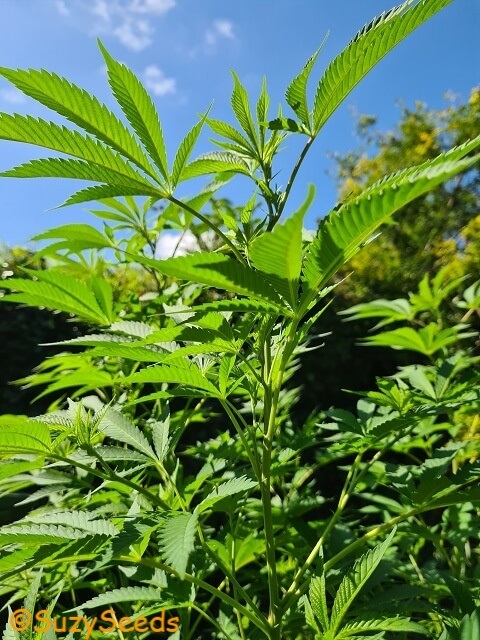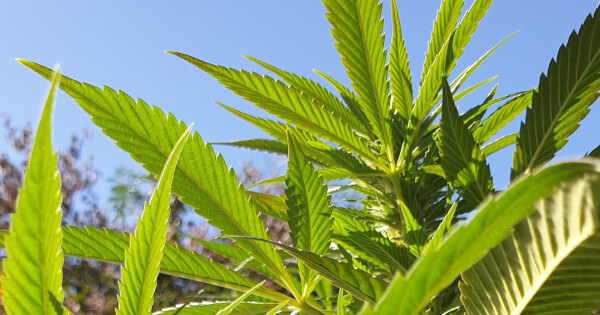Cannabis Vegetative Phase – Your Complete Growth Guide
When your seedling pokes through the soil after germination, the cannabis vegetative phase begins – the make-or-break stage where your plant gears up for a killer harvest, and Suzy Seeds’ expert guide, refreshed for 2025, has you covered indoors and out. With over 26 years breeding premium seeds, we’ve mastered this 3-8 week stretch where lobed leaves give way to serrated “fingers,” multiplying from one to many.
Sativas soar meters high, Indicas bush out, and autoflowers like AK47 Auto keep it tight – all prepping for yields you’ll see in the Flowering Phase. Sex hides until bloom, so opt for feminized seeds like Leila Kush to skip males. Nail this phase with expert cannabis vegetative phase tips, and your buds will thank you.
The growth phase of cannabis
When the seedling emerges above the ground after germination, the growth phase of the cannabis plant begins. The young plant begins to develop leaves. The first leaflets to unfold from the seed are the lobe leaves, then the characteristic serrated leaves that start with one "finger" form. The next leaves get more and more fingers.
Depending on the variety and strain, as well as the conditions, cannabis plants can grow into trees several meters high. Some are short and bushy with many branches and a thick trunk. Others are thin and elongated or are a combination of both. Autoflowers will not reach great heights because they will flower on their own, but they do have a growth phase as well. The sex of a cannabis plant can only be seen when it starts to flower, so sow feminized seeds to be on the safe side.
Growth phase outdoors
Outdoor growing hinges on climate and daylight. In mid-western Europe, May 2025 kicks off the season – germinate by mid-April for pre-growth under shelters, using 18-hour light supplements (e.g., LED panels) to dodge early chills below 15°C. Sativa-dominant strains like Amnesia Haze crave tropical warmth (22-28°C), while Indica-heavy Hollands Super Bud thrives in milder zones (18-25°C). Match your strain to your region – check Suzy Seeds’ strain notes for climate fits.
By August, shortening days (12-14 hours) trigger flowering, though some strains bloom earlier or later. Pre-growing stretches the vegetative phase, letting plants hit 2-3 meters, but heavy buds risk snapping branches in wind or rain.
Support with stakes or wire mesh, and use topping (cut the main stem) or LST (bend branches) to shape bushier, sturdier plants. Darkening with tarps in July can force early flowering, aligning buds with peak summer sun. Greenhouses amplify control – vent them well to avoid mold at 60-80% humidity.
Growth phase Indoors
Indoor growing, you rule the seasons, harvesting multiple times yearly. Seedlings hit 18-24 hour lights post-emergence – dim LEDs or HPS (200-300 watts) at 50-70 cm for starters, dropping to 30-50 cm as they harden. In a 1m² room, veg 9 plants for 1-2 weeks or 4 for 3-6 weeks. Autoflowers like Blue Berry Fruit Auto stretch less, while Tangerina Punch doubles in the “stretching phase” after switching to 12/12 – cap height at 60-90 cm to save buds from heat. Nitrogen-rich feed (10-5-5 NPK) powers growth, halved for autos. SOG (dense small plants) or SCROG (screen-trained canopy) evens light – overcrowding dims lower buds. Keep 21-25°C, 50-70% humidity, and fans humming; mother plants thrive on 20/4 for cuttings. Learn more techniques at our Growing Methods Guide.
Suzy’s Tip: With an indoor grow, the yield does not always depend on the size of the plants. Plants that are too large will smother each other and their buds will not get the optimal light, resulting in a lower yield than expected.
 Growing medium
Growing medium
The growing medium in which you grow the plant affects the speed of growth. The most common substrates for growing cannabis are soil, coco and hydro. Each surface has its own qualities, advantages and disadvantages. Every grower has his preference.
Soil
Soil is a perfect medium for novice growers because it contains nutrients on its own so you don't need to feed as much. By experimenting with soil, you expand your growing knowledge. If you want to grow your plants in soil, you should pay close attention to the type of soil you buy.
There is an enormous amount of choice. You have cheap bags of soil, such as those sold in garden centers. In principle, you can grow your plant in this, but this can cause a lot of problems, especially for beginners. This soil does not contain enough nutrients for a cannabis plant, is not airy enough and quickly becomes hard and dry.
Good air-permeable soil is important for the development of the roots of your cannabis plant and with this soil the plant will grow more vigorous, healthier and stronger. You can add perlite (small, white stones) to the soil, which makes the soil more airy, but personally I would think: why make it difficult when it can also be done easily?
I prefer to buy soil in a specialized grow shop, which you can find all over the world. Here you can buy good soil intended for growing a cannabis plant. These high quality soil mixes are airy, usually because perlite has been mixed in, and contain enough of the necessary nutrients. It may cost a little more, but I'm happy to pay for quality. The biggest advantage of good soil is that your plant needs little extra attention.
Soil is very important to your plant, so if you want to save money, do it on everything but the soil. If your budget really does not allow you to buy good soil, it is best to buy cutting soil. This is the most expensive among regular soil mixes, but of the best quality. In any case, do not use compost used for growing flowers, as this soil is usually too acidic for a cannabis plant.
Coco Coir
Coco coir is an oxygen-rich fiber that you can use to grow exuberant plants. An experienced grower harvests more with a cultivation on coconut. Because it is a neutral medium, you will have to add liquid nutrients yourself. By doing this at the right time and in the right amount, you get maximum yield from the plant. Herein lies the disadvantage. If you give the young plant too little or too much nutrition, this can have serious consequences for the rest of the growth and flowering of the plant.
Suzy’s Tip: If your plant has deep green leaves, this is a sign that it has enough nutrients. If you're not sure if you need to give your plant more food, wait until the leaves turn a lighter green before adding nutrients. Don't wait too long either, because then the leaves will turn yellow.
Hydroponic
To grow with a hydro growing system you need some knowledge and experience. First start growing on soil or coco before you start hydro growing. You must, as it were, be able to read the plant and know which nutrients it needs.
It is necessary to maintain the EC and pH values. The plant reacts immediately to what you do and you cannot make any big mistakes. So this is really for the more experienced grower. However, if you know what you are doing, you can achieve a good yield with this growing method. Growing with a hydro system will give you the fastest growth rates, as long as you do it right. This is due to the large amount of oxygen available to the roots.
Light cycle of the growth phase
Aside from autoflowers, cannabis plants will grow in as little as 14 hours of light and 10 hours of darkness. This is not really optimal, the plants can stagnate in growth or stress, but it is possible. To prevent this, it is best to use 18 hours of light and 6 hours of darkness. This gives the plant long enough light for optimal growth without risks.
At night, during the dark period, the plant produces flowering hormones and 6 hours of darkness is too little for the plant to produce those hormones and actually switch to the flowering phase. For an autoflower this is a different story and the 18/6 light schedule is even ideal for the entire life cycle of the plant. With mother plants, a light schedule of 20/4 is more often used to speed up the production of cuttings. The cuttings are then continuously under the lamp for the first few days to root extra quickly.
Irrigation in the growing period
Cannabis likes a nice moist environment during growth, but doesn't like having wet feet. You do not necessarily need an expensive humidifier, with a bowl of water or a few wet cloths you can quickly increase the humidity in the grow room. Watering is best done as carefully as possible, especially in the beginning. Water as little as possible, but do not allow the medium to dry out. If you grow in a pot you can lift it to feel how heavy it is. The heavier the pot, the moister the medium will be.
A medium that is too moist inhibits the growth of the root system, the roots are not stimulated to look for moisture, so they grow less. By watering at the edge of the pot and not at the trunk, you also stimulate the roots to grow towards it.
Check the plant, medium and humidity daily and water as needed. It is better to give a small amount of water several times than a lot at once. Make sure the water is at the right temperature and water the plant with a watering can. Young seedlings in small pots are still delicate, so moisten them with a plant sprayer and check them every day.
 Conditions during the growth phase
Conditions during the growth phase
Nutrients
Nitrogen, Phosphorus and Potassium (N-P-K) are the components of cannabis nutrients. For nutrition for the growth phase of cannabis plants, it is recommended to maintain an N-P-K ratio of 2-1-1, 2-1-2, 3-1-3. Using a root stimulator can work very well, but pay attention to the manufacturer's instructions.
PH value
The acidity is expressed in pH. This influences the form of the nutrients present in the medium. A good soil pH is between 6 and 6.5. With hydro this is between 5.5 and 6.0.
EC Value
EC is a conductivity value and indicates when the plant absorbs the maximum amount of water and nutrients. This value is different in every life phase of the plant. Start with a young seedling with an EC value of 1.2. You can gradually increase this to 1.6 during the growth phase.
Temperature
The ideal temperature for growing a cannabis plant is between 21 and 28 degrees Celsius. Temperatures may be slightly lower at night, between 17 and 23 degrees. As long as the difference in temperature between day and night is not too great. It is best to keep the temperature of the (feeding) water around 20°.
Humidity
Maintain high humidity during growth, so they can develop quickly and keep the growing period short. A humidity above 60% is perfect. For cuttings and young seedlings even up to 80%.
Ventilation
Ventilation is a necessity to provide sufficient fresh air to the growing plant. The plant extracts carbon dioxide CO2 from the air and uses it to convert light into energy for the plant, this is called photosynthesis. The oxygen that remains after this process is exhaled by the plant. And a small fan that moves the plant ensures a thick, healthy trunk.











